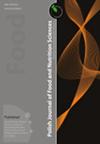Jamun种子:生物活性成分、营养价值和健康益处综述
IF 2.3
4区 农林科学
Q3 FOOD SCIENCE & TECHNOLOGY
引用次数: 7
摘要
Jamun果是杨梅科的一员,因其果肉甜、酸、涩、甘美而在世界热带和亚热带地区商业种植。在将果肉工业加工成饮料、果冻、果酱、醋、葡萄酒和南瓜的过程中,果酱的种子被当作垃圾丢弃。这些种子是生物活性化合物的潜在来源,包括可水解单宁、酚酸、黄酮类化合物、其他酚类化合物、萜类化合物、间苯三酚衍生物和皂苷,这些化合物已被认可具有多种生物活性,如抗糖尿病、抗癌、抗炎、抗氧化、抗菌、抗高血压和抗高胆固醇血症,以及心脏保护、肝保护和神经保护特性。在果酱种子中也发现了高含量的碳水化合物、膳食纤维、矿物质和抗坏血酸。然而,这些种子作为有益健康的创新工具的潜在用途尚未得到充分了解。我们的目的是汇编关于jamun种子营养概况、生物活性化合物组成、生物活性特性及其作为功能性食品配方成分的潜力的科学研究和最新进展。本文章由计算机程序翻译,如有差异,请以英文原文为准。
Jamun Seed: A Review on Bioactive Constituents, Nutritional Value and Health Benefits
Jamun fruit, a member of the Myrtaceae family, is commercially grown in tropical and subtropical areas of the world for its fruits with sweet, sour, and astringent luscious flesh. Seeds of jamun fruits are discarded as trash during the industrial processing of fruit pulp into beverages, jellies, jam, vinegar, wine, and squash. These seeds are a potential source of bioactive compounds including hydrolysable tannins, phenolic acids, flavonoids, other phenolics, terpenoids, phloroglucinol derivatives and saponins, which have been endorsed several biological activities, such as antidiabetic, anticancer, anti-inflammatory, antioxidant, antimicrobial, antihyperlipidemic and antihypercholesterolemic, as well as cardioprotective, hepatoprotective and neu - roprotective properties. High contents of carbohydrates, dietary fiber, minerals, and ascorbic acid have also been found in jamun seeds. However, potential utilization of these seeds as innovative implements for health benefits has not yet been fully understood. We aim to compile scientific research and recent advances on jamun seed nutritional profile, bioactive compounds composition, bioactive properties, and their potential as an ingredient in functional food formulation.
求助全文
通过发布文献求助,成功后即可免费获取论文全文。
去求助
来源期刊

Polish Journal of Food and Nutrition Sciences
FOOD SCIENCE & TECHNOLOGY-
CiteScore
4.30
自引率
12.50%
发文量
25
审稿时长
20 weeks
期刊介绍:
The Polish Journal of Food and Nutrition Sciences publishes original, basic and applied papers, reviews and short communications on fundamental and applied food research in the following Sections:
-Food Technology:
Innovative technology of food development including biotechnological and microbiological aspects
Effects of processing on food composition and nutritional value
-Food Chemistry:
Bioactive constituents of foods
Chemistry relating to major and minor components of food
Analytical methods
-Food Quality and Functionality:
Sensory methodologies
Functional properties of food
Food physics
Quality, storage and safety of food
-Nutritional Research Section:
Nutritional studies relating to major and minor components of food (excluding works related to questionnaire
surveys)
-“News” section:
Announcements of congresses
Miscellanea
 求助内容:
求助内容: 应助结果提醒方式:
应助结果提醒方式:


